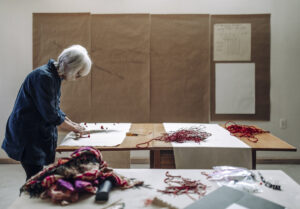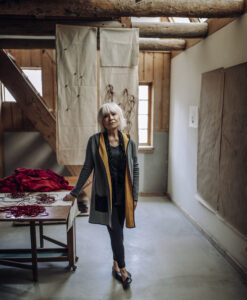By SCOTT MCKIE B.P.
ONE FEATHER STAFF
For Cherokee artist Luzene Hill, the COVID-19 pandemic has been challenging, but it certainly hasn’t stopped her from sharing her work with the world. She recently finished a virtual residency at IAIA MoCNA (Institute of American Indian Arts Museum of Contemporary Native Arts) as well as being a visiting artist at the Anderson Ranch Arts Center in Colorado.

Luzene Hill, a member of the Eastern Band of Cherokee Indians, is shown in her studio at the Anderson Ranch Arts Center in Colorado where she was a visiting artist. (Photos contributed)
“Last winter, when I was invited to be a Social Engagement Artist-in-Residence, I began working on ideas for a public ‘performance art’ project designed to involve students and other artists,” said Hill, a member of the Eastern Band of Cherokee Indians. “Due to COVID-19, the residency was postponed until October and then eventually evolved into a virtual residency.”
She said it was challenging in parts. “It was intense in some ways as I’m a techno-phobe and not facile with Instagram and blogging. Specifically, I was given a one-day takeover of the IAIA MoCNA Instagram account, which involved posting every couple of hours, and a Squarespace website was set up for me to blog every day for three weeks.”
Hill said this experience helped her tremendously. “I believe the virtual nature of the IAIA MoCNA residency enhanced my online profile enormously. The necessity to learn how to navigate Instagram better and to be comfortable with blogging gave me new skills that I can use in the future. The exposure by IAIA and Anderson Ranch, via their larger internet presence increased the audience range for my work. In addition, I’m feeling more secure in my art practice and more confident in following my instincts.”
She described the experience as a visiting artist at Anderson Ranch as “marvelous” and noted, “It was only a week, but that time constraint made it intense and very focused. I was provided with a cozy apartment, a beautiful studio and anything I needed in terms of equipment and technical assistance. The staff was wonderful, and the equipment and workshops are state-of-the-art!”
While there, Hill began work on a new installation entitled “Traces and Wounds” which she states will be “three separate installations addressing the issues of colonization and violence against Native women”. Then, those three installations will be combined into one large exhibition.
While COVID-19 has caused changes to Hill’s life and schedule as an artist, she has gone with the flow and turned those challenges into opportunities. “The pandemic was, and continues to be, a challenge simply to function on a day-to-day basis. Last January, I was looking forward to exciting trips and residencies in the spring and summer, and it was a blow to realize those wouldn’t happen, or best case, would be postponed indefinitely. So, from April to late summer in many ways I was in limbo, with some events and deadlines confirmed, others remained tentative. I’m grateful almost all the art events planned at the first of the year eventually happened, some in-person, more or less as planned, and others virtually.”
 She added, “It was reinforcing to see art organizations and other artists continuing to push forward and adapt to the circumstances. The need to travel at this time was a challenge. I had to be in various locations in New Mexico, Colorado, and Wyoming over a three-month period. I chose to drive out and stay in the West, rather than fly back and forth three times. I had been strictly quarantining with my immediate family in Atlanta since the end of March. I would never have travelled if it were not for my art. Now that my trip is almost over, I believe the risk and stress was definitely worth it, for my art and for me personally.”
She added, “It was reinforcing to see art organizations and other artists continuing to push forward and adapt to the circumstances. The need to travel at this time was a challenge. I had to be in various locations in New Mexico, Colorado, and Wyoming over a three-month period. I chose to drive out and stay in the West, rather than fly back and forth three times. I had been strictly quarantining with my immediate family in Atlanta since the end of March. I would never have travelled if it were not for my art. Now that my trip is almost over, I believe the risk and stress was definitely worth it, for my art and for me personally.”
Hill said COVID-19 hasn’t changed her work much though. “Regarding COVID-19’s effect on my studio practice, being isolated and confined is what I do as an artist anyway. I’ve never been more grateful to be an artist, because having a focus, continuing to do my work, has kept me sane through the pandemic crises swirling around us.”
The fall 2019 recipient of the Ucross Fellowship for Native American Visual Artists, Hill was also named a 2016 NACF (Native Arts and Cultures Foundation) Fellow as well as receiving an Eiteljorg Museum Fellowship and First Peoples Fund Fellowship in 2015.



